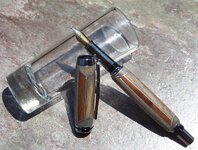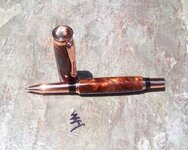bfgladden
Member
The first pen is pecan and hackberry with aluminum. It was going so well until it came time for finishing. I wasn't thinking and used EEE and the entire pen turned black from the aluminum :frown:. (Anyone have any tips for finishing a pen with aluminum accents without getting the dust all in the grain?) Managed to get it mostly back to the correct color. Then when I was pressing it together, one of the scallops separated from the pen......
The second pen I was quite happy with. Its the Alchemy blank from ExoticBlanks.com on a Copper Jr. Retro.
As always, comments and critiques are welcome and appreciated.
The second pen I was quite happy with. Its the Alchemy blank from ExoticBlanks.com on a Copper Jr. Retro.
As always, comments and critiques are welcome and appreciated.


